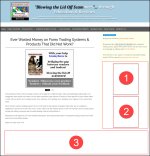- Home
- Forex Articles
- Forex Trading
- 5 Main Characteristics of the Currency Futures Markets
5 Main Characteristics of the Currency Futures Markets
by FinanceAttitude.com

Currency future is also known as forex futures or foreign exchange futures and is essentially a futures contract to buy or sell a specified amount of a particular currency at a set price and date in the future. Majority of the most popular futures markets are based upon currencies and are offered by the CME (Chicago Mercantile Exchange).
There are various currency pairs offered for trading via futures contract and include: EUR - The Euro to US Dollar currency future, GBP - The British Pound to US Dollar currency future, CHF - The Swiss Franc to US Dollar currency future, AUD - The Australian Dollar to US Dollar currency future, CAD - The Canadian Dollar to US Dollar currency future, RP - The Euro to British Pound currency future, RF - The Euro to Swiss Franc currency future among others.
Currency futures are in essence traded the same as all the other futures markets like index and commodity futures markets etc.
Currency futures shift in increments known as ticks, and each tick movement has a value. The number of ticks made or lost on a trade determines the loss or the profit of the trade. The trader must have a set minimum amount of capital in their account to open a currency futures trade called the margin.
There are several currency futures contracts to trade, and the specifications for each should be checked on the exchange website before trading it.
Here are the 5 key characteristics of the currency futures markets:
1. Traded via Exchanges
Currency Futures are futures contracts based upon currencies and have some significant differences from forex which is basically the currency markets. The main differences are whereas currency futures are traded via exchanges such as the Chicago Mercantile Exchange (CME) currency markets are traded via currency brokers.
Currency markets are thus not as regulated as the currency futures. Currency markets are thus prone to some setbacks like currency brokers can trade against their clients and the pricing is also not centralized and is determined by the particular brokers although the minimum amount is set by the exchanges.
2. Only Trade in One Contract Position Size
Currency futures trade in one contract size and so traders must trade in multiples. On the flip side, currency markets are advantageous in that it is much more flexible and allows the traders to access high leverage and trading in very specific position sizes. For example, buying a Euro FX contract means the trader is in actual fact holding say 125,000 Euros. In the actual forex market, a trader can trade in multiples of $1000, and can, therefore, adjust their position size to a much greater degree.
3. Settlement/Delivery is Usually in Cash and in the Underlying Currency
Currency futures are based on the exchange rate of a currency pair and are settled in cash in the underlying currency. For example, the EUR futures market is based upon the Euro to US Dollar exchange rate, and its underlying currency is Euro. In the example above, When an EUR futures contract expires, the holder receives a delivery of $125,000 worth of Euros in cash and this only happens when the contract expires except for day traders.
4. Trading is for Speculation
Day trading and a person trading currency futures for speculation/profit earn a profit based on the price difference between what they buy the contract at and the price they sell it at. It is also possible with futures, to first sell and then buy later and make a profit if the price drops.
The profit on a trade in the currency futures is calculated as the difference between the entry price and exit price (in ticks), multiplied by the tick value, and multiplied by the number of contracts taken on the trade. For example, assume a trader buys a Euro FX contract at 1.2525 and then sells it at 1.2545. The difference is a 20 tick profit, and each tick in that contract is worth $12.50. Therefore, the profit is $12.50 x 20 and finally multiplied by the number of contracts the trader had acquired. Each currency contract may comprise a different tick value and it can be checked on the exchange website (CME).
5. Trades With a Margin
The margin in Currency futures refers to the amount of money that the trader must have in their account in order to open one contract trade. This is different from currency markets margin/leverage in stocks or the underlying currency market.
Final Word
We hope this guide has offered you some valuable insights on currency futures trading.
To view the original version on Finance Attitude, visit: FinanceAttitude.com





